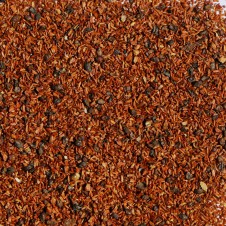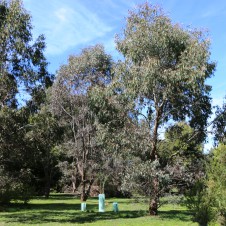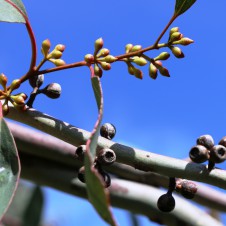

 General Description: Generally a broad-crowned, medium to tall tree to 30 m tall. Bark dark brown, fibrous and flaky on lower half of trunk, creamy-yellow and smooth on upper trunk and branches.
General Description: Generally a broad-crowned, medium to tall tree to 30 m tall. Bark dark brown, fibrous and flaky on lower half of trunk, creamy-yellow and smooth on upper trunk and branches.
Flowers and Fruit: Creamy, white flowers produced mainly from December to January.
Fruit is wineglass-shaped, pedicels distinct, 6-13 mm long; disc flat but recessed below rim; valves 4-6, enclosed.
Site Preference and Tolerances: In sheltered sites near rivers or in open, poorly-drained, relatively flat country. Tolerates heavy frost and has moderate salt tolerance.
Life Span: Long-lived (80+ years)
Wildlife Value: Occasionally used by koalas for food. The sweet-smelling blossoms attract possums, birds and insects. Honeyeaters and lorikeets are attracted to the nectar. Old trees form good hollows.
Other Values and Uses: An excellent honey producer and the most popular of Victorian honeys, the honey remains liquid almost indefinitely. Excellent firewood. Timber is very hard, heavy and strong and has been used for heavy engineering construction, poles, railway sleepers and fencing. An attractive specimen tree for parks and roadsides.
Germination Information: germinates best at 27C. Can be propagated easily from seed and will direct seed well if weeds are controlled. Usually germinates in 2-5 weeks.
